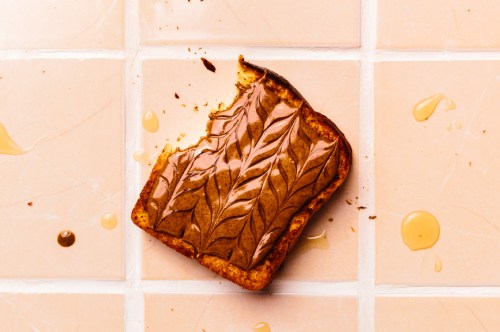How To Tell if Your Peanut Butter Has Gone Bad (Because It Probably Has)
Answering the age-old question: Does peanut butter *actually* go bad?

The nostalgia of a quality PB&J sandwich can quickly take you back to your childhood in the first bite. And honestly, nothing’s changed; I will never stop reserving a special spot in my pantry for peanut butter. Something about the slightly salty spread—paired with a sweet and tart jam or jelly—always hit the spot growing up. The best part: Peanut butter is good for you, shown to reduce cardiovascular and liver diseases with regular consumption. In fact, a registered dietitian previously crowned it the best nut butter of them all on Well+Good. (I mean, what else will you reach for when you need a post-workout pick-me-up, an ideal hiking sandwich spread, or a midnight snack?)
That being said, while some can easily go through an entire peanut butter jar in a week (shoutout to parents with little ones), most consumers actually take a few to several months to reach the bottom of the container. All good, whatever your pace, save for the fact that this beloved spread spoils a lot faster than you assume.
So, how fast exactly does peanut butter go bad? Despite the fact that it appears to last virtually forever, peanut butter often expires within just a few months after opening or even sooner. Here, we’ve gathered a few pointers for determining whether your creamy-slash-crunchy nut butter has spoiled or is still usable with indicators like smell, taste, and appearance.
Does peanut butter go bad?
As peanut butter contains minimal water due to its high fat content (less than one percent), a sealed jar of the spread can sit in the pantry for anywhere from six months to two years before spoiling if it’s made with preservatives like sodium benzoate—a pickling agent that inhibits bacteria growth. However, an opened jar (which exposes the spread to microorganisms fueled by oxygen) can only last two to three months, depending on the type and how it’s stored. An unopened jar of natural peanut butter will last just six months maximum at room temperature, unopened; once opened, it will likely start to turn after just a month.
Why? Studies show that natural peanut butters made without oil, sugar, or stabilizers tend to have a shorter shelf life than those made with stabilizers and preservatives. Once an opened jar of nut butter begins to interact with environmental factors, its oxidative stability—the chemical reactions between fatty acids and oxygen that cause rancidity—begins to decrease.
How do you know your peanut butter is expired?
A jar of nut butter that's past its prime will begin to taste rancid, bitter, or overly pungent. According to a study on the quality of natural peanut butters during storage, natural PB kept at 50°F (10°C) began demonstrating loss in oxidative stability (or freshness) after just 12 weeks. Alternatively, when stored at higher temperatures of 77°F and 95°F (25°C and 35°C, aka closer to your kitchen’s room temperature), the stability shortened to only four weeks.
Aside from the yucky taste of rancid peanut butter, the spread will also emit a foul odor. If the spread gives off a bitter, metallic, or soap-like scent, it is time to part ways. Additionally, if the color darkens, the texture becomes dry, or there are signs of mold growth, the peanut butter has gone bad. However, don’t be alarmed by natural oil separation; it’s completely normal and a sign of good-quality natural nut butter. And, of course, always check the expiration date to use as a starting point of reference.
How to store peanut butter so it lasts longer
Although peanut butter is one of those foods that don’t need to be refrigerated (technically speaking), it can definitely benefit from some cooler temperatures. In fact, storing nut butters in a dry, cool environment can help them stay fresh for longer. So, should you refrigerate peanut butter after opening? You bet (that is, if it takes you a while to get through an entire jar).
Once opened—if you don’t expect to be using it up in the immediate future—simply place the jar in the fridge to reduce moisture exposure and bacterial growth, which will add months to its shelf life. If you see separation occurring between the solids and oils, flip the jar upside down when stashed away. This will help re-incorporate the ingredients once flipped back, right side up. (Or if you’re pressed for time, agitating the separated liquids with a spoon or spatula will always do the trick.) You can also soften cold peanut butter fast by simply leaving it out at room temperature for 10 to 15 minutes.
Tips to extend the shelf life of your peanut butter
If your household doesn’t consume peanut butter regularly and you’re looking for a way to cut back on food waste, freezing the nut butter will buy you even more time to use it up—think years (!). But this is best for a long-term pantry stocking case; how can you freeze it without having to regularly defrost the entire jar to simply get a spoonful out? We’ve got two genius hack so you can always have ready-to-eat PB in mere minutes, no broken spoons in sight.
1. Freeze it into single-portion cubes
Transfer the contents of your opened jar of PB to ice cube trays to freeze the spread in convenient single-portion chunks. Once solid, drop them into freezer bags for easy access. When ready to use, grab the desired portion out of the bag and simply defrost it for a few minutes. Before you know it, you’ll have pre-portioned cubes of peanut butter conveniently ready for baking a batch of gooey banana peanut butter brownies, decadent peanut butter banana bread, or even just for overnight oats. Swoon. Plus, the single portions are also ideal for a pre-bedtime banana and peanut butter snack that can help boost relaxation and aid in better sleep. We love.
2. Freeze it into no-spreading-necessary, ready-to-eat sheets
Better yet, according to a viral TikTok video, you can also enlist your freezer to make the most perfect vegan peanut butter and jelly sandwich. This trick helps you avoid those terrible bread tears (which can happen as you spread your glob of peanut butter) by freezing thin layers of the nut butter on parchment paper for ready-to-use portions. It also frees up more freezer space than storing a bag of cubes. In the video, Eitan Bernath explains that you should start by spreading a large amount of peanut butter on a sheet of parchment into a thin layer using a spatula. Then, cover the layer with another sheet of parchment paper and press firmly with your hands or using a rolling pin to smooth out the peanut butter into an even, uniform layer.
Next, freeze the parchment-lined peanut butter on a flat sheet tray for at least half an hour to an hour. You can perform the same steps and freeze thin sheets of jam, too (though depending on the consistency, it may not freeze as well as the peanut butter). Once the spreads have completely frozen, remove them from the tray, and cut them into individual-sized portions. If making a traditional PB&J sandwich, cut the layers to match the shape of your bread. Lastly, carefully remove the parchment paper before assembling your sandwich. The result? A delicious PB&J sandwich, minus the torn bread (and more importantly, no expired peanut butter in sight).










